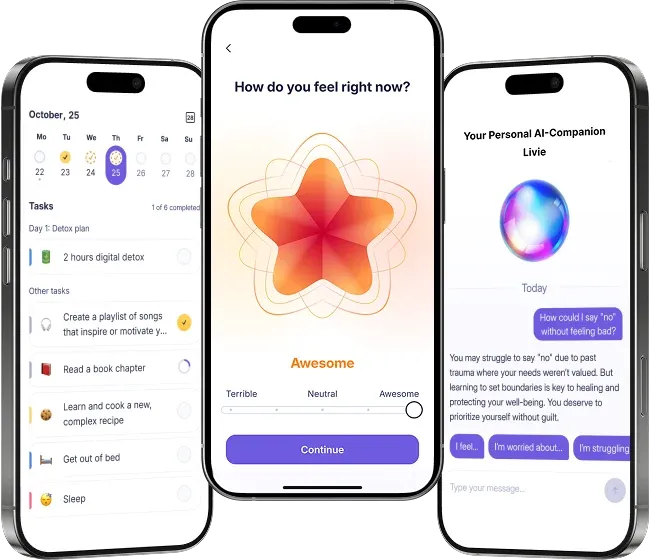Depression in the Workplace: Signs, Solutions, and Seeking Support

What often starts as fatigue or disengagement can quickly spiral into more serious issues like workplace stress and depression.
Unfortunately, coping with mental health at work has become a silent challenge for many, especially in organizations where this topic is still a taboo.
But the impact of workplace stress and depression goes beyond mood and productivity. Untreated depression is linked to physical health problems, including increased risk of heart disease and weakened immunity.
So, what can you do if you’ve already spotted a few telltale signs of depression? Let’s find out.
Top reasons for workplace depression
Workplace depression is way more common than we expect it to be. Industries lose up to 12 billion working days per year globally due to depression and anxiety, which equals around $1 trillion in lost productivity.
Here are the top three workplace problems that can potentially cause mental health conditions like depression.
- Toxic work environment. This often includes bullying, discrimination, or passive-aggressive behavior combined with high tension and negativity that fuel depressive symptoms. Such environments directly impact a person's ability to collaborate and feel emotionally safe.
- Excessive workloads and unrealistic expectations. Constant heavy workload stress and the lack of boundaries between work and personal life result in chronic anxiety, burnout, and eventually more serious mental health problems.
- Harmful organizational culture. A culture of overwork that discourages self care or, worse, has a stigma around mental health issues, unfortunately, sets the tone of negative employee well-being.
So, these are the risk factors that contribute to workplace depression. But how to recognize that it’s exactly the depression you’re dealing with? Let’s find out.
Stress, burnout, or depression? The subtle signs and differences
Basically, stress is when you’re overwhelmed but still able to function. Probably, you’ve been juggling work life balance for a month or two or recently moved to a new city and the change has only added stress to your life.
When you’re dealing with constant job stress, you might experience:
- Muscle tension, irritability, or trouble sleeping
- Difficulty concentrating on tasks;
- Missed deadlines and generally poor decision making at work;
- Lost productivity.
If left unmanaged, work stress will easily lead to more serious problems like heart disease, burnout, and, eventually, work depression.
You can take a long vacation and bounce back from slight, short-term job stress really fast. However, that’s not the same with the burnout.
Work burnout is a state of emotional, physical, and mental exhaustion caused by prolonged exposure to stress factors like unrealistic demands, lack of support from co workers, or poor work life balance. It's not a separate psychiatric diagnosis, but it can definitely trigger depression and remain a part of it.
Work burnout signs might include:
- Emotional detachment from your work
- Decreased work performance and lack of motivation
- Cynicism or negativity toward your job or co workers
- Difficulty dealing with tasks that once felt easy
It’s way more difficult to bounce back from burnout, but still very possible with the right self care tips like setting boundaries between work and personal life.
Unlike burnout or stress, depression is a diagnosable medical condition that often extends beyond work. In other words, you can’t treat work depression with a few vacation days. Oftentimes, you’ll have to get professional support, especially if you’re dealing with severe depression that might require medication. Other times, talk therapy combined with healthy sleep, food, and exercise might be enough if your depression is mild.
❗ Please don’t hesitate to ask for professional help if you spot the following depressive symptoms:
- Persistent sadness and hopelessness
- Withdrawal from your colleagues, friends, or family
- Severe fatigue that is persistent regardless of rest or sleep
- Guilt, worthlessness, or suicidal thoughts
- Lost interest in things you once enjoyed
Now when you know the difference between these states, we need action. And this brings us to the most essential question…
How to make work less depression-inducing?
You won’t always have to switch careers or wait for a significant change in your company’s culture to regain your positive well being. Sometimes, small, intentional steps can have a massive effect on your mindset, energy, and work life balance.
Here is where to begin.
#1: Re-arrange your entire approach to work
Let’s be real: we’re not in The Devil Wears Prada, and working long hours with zero boundaries isn’t a badge of honor and has never been. So, the best thing to do is rethink how you interact with your job on a daily basis.
🚧 Start with setting boundaries.
- Create a daily "start" and "close" ritual. You can start with a mindful cup of coffee in the morning and finish with a quick walk and an intentional laptop power-off in the evening.
- Put some work into setting EMOTIONAL boundaries too. Avoid draining conversations with co workers that leave you depleted and make a rule not to talk about work with your colleagues, friends, and family beyond working hours.
- Make space for something non-work during your day. A walk in the park, a chat with a friend, or a lunch break away from your desk can refresh your brain.
🌿 Bonus tip: Divide and conquer. Break big projects into smaller, manageable chunks. Not only is it a great way to reduce overwhelm, but also an opportunity to create mini-wins that boost motivation and keep the happiness hormones flowing.
A good thing is to also reward yourself each time you complete a work chunk with a 10-minute stretch, a cup of your favorite beverage, etc.
#2: Try body-based grounding techniques if anxiety accompanies your depression
Over 60% of patients diagnosed with depression suffer from anxiety as well. If you’ve been experiencing anxiety symptoms like racing thoughts, muscle tightness, and trouble concentrating, a few grounding techniques can help.
These science-backed techniques below can support your overall well being and even reduce symptoms like restlessness, mental fog, and emotional overwhelm.
- 5-4-3-2-1 grounding. Find 5 things you can see, 4 you can touch, 3 you can hear, 2 you can smell, and 1 you can taste. This exercise helps your brain shift focus away from anxiety and reconnect with the present moment.
- Practice deep breathing or guided breathwork to calm your nervous system. A simple exercise like ‘inhale for 4 counts, hold for 4, and exhale for 6’ might be helpful.
- Add mindfulness meditation to your daily routine. Even 5 minutes can reduce work anxiety and improve focus.
These techniques are helpful when you can’t influence the external factors but want to regain the sense of control and feel calm inside.
🌱 Bonus tip: A total beginner in breathwork and meditation? Try guided meditations with apps like Insight Timer, Headspace, or Calm. You can try different meditation types and choose the ones that really do work for you. Plus, you can easily set a streak challenge with a digital tool and stay accountable.
Again, if you’ve been struggling with severe anxiety for quite a long time, please don’t hesitate to reach out to a mental health professional. Your feelings are valid! And with the right support, things can really get better. 💚
#3: Reach out to your employer
Companies today are increasingly aware of how public health and mental health conditions intertwine at work.
Talk to your employer or HR department. Ask for:
- Flexible hours. Perhaps there are hours during which it’s easier for you to concentrate and accommodate therapy appointments or self‑care routines;
- Mental health leave. Yes, some companies have this option;
- Work environment adjustments. Request a quieter workspace or occasional remote days;
- Where you can find employee assistance professionals. Use confidential counseling services, workshops, or referrals to clinical support at no extra cost to you.
🌿 Bonus tip: Ask for peer support networks. Connect with colleagues or join company‑sponsored groups where workers share experiences, coping strategies, and encouragement.
#4: Engage in therapy and reclaim your sense of self
It’s easy to get lost in a high-pressure work environment and forget about self care. Meanwhile, therapy gives you space to talk, reflect, and rebuild a healthy relationship with your thoughts and emotions.
Therapy can be a powerful first step back to yourself if you’re feeling depressed, especially if you choose cognitive behavioral therapy (CBT).
This structured, evidence-based approach helps you identify negative thought patterns and substitute them with more balanced thoughts.
Here is how CBT, one of the most effective therapeutic approaches according to multiple studies, can help a depressed employee:
- It puts you back in control. CBT equips you with tools that help you reframe negative thoughts;
- It’s focused, collaborative, and time-sensitive. You won’t dig endlessly into the past during the sessions. Sure, you’ll address childhood trauma, but the main focus of your therapy will be to process your past and focus on the current factors that impact your life (toxic work environment included).
- You get a safe space to talk. Regular sessions allow you to talk openly, reflect on your experiences, and process difficult emotions;
- CBT helps you understand which things contribute to your distress. You can finally pinpoint what’s driving your low mood and target the issues;
- It lowers the risk of worsening depressive symptoms. When left unchecked, negative thoughts can spiral and lead to more serious mental health conditions or worsen the ones you’ve already got.
- The best part? CBT offers lasting benefits. The goal of CBT is to equip you with coping strategies so you don’t have to stay in therapy life-long and can help yourself navigate challenges when work or life gets overwhelming.
🌱 Bonus tip: Sometimes, the therapist you choose just isn't the right fit. Your personalities might not click, and that’s okay. It doesn’t mean therapy isn’t for you. The best thing you can do is keep looking until you find someone you feel safe and connected with.
Advice for employers: How to recognize someone struggling with depression at work and help
Workplace stress and depression can silently undermine performance, productivity, and morale, often long before a depressed employee ever says a word. And that’s the biggest problem because most employees are coping with mental health challenges at work without the right tools and support.
As a leader in your organization, you can step up and create a work culture that doesn’t contribute to work depression in the first place.
Here is what you can do for mental health employee support if you’re an employer:
- Normalize mental health conversations. Encourage your team to talk about mental health and ask for help when needed, even if it’s a simple 2-day leave when they feel too overwhelmed and need to recharge.
- Make sure your employee assistance program (EAP) is well-promoted and easy to access. Outline the services offered, such as counseling, stress management resources, and referrals to employee assistance professionals.
- Train managers how to spot emotional distress, respond, and contribute to solutions, not stigma.
- Offer flexible hours, remote work options, and paid time off when employees are overwhelmed by only family crisis or emotional strain.
- Create a work environment that promotes well-being.
- Encourage regular breaks, realistic workloads, and space for personal lives. Don’t reward overwork or treat exhaustion as a badge of honor.
When to seek professional guidance?
If you’ve been feeling depressed for more than two weeks and struggling with extreme fatigue, it might be time to see a mental health professional.
Unfortunately, persistent low mood, fatigue, hopelessness, or loss of interest in daily activities may be signs that you’re going through severe depression.
Please remember that your pain is valid. Your healing is possible. And you don’t have to go through it alone. 🤗
Final thoughts: You deserve to feel better at work
Depression in workplace is a whole-body experience that affects energy, motivation, relationships, and even physical health.
And guess what, your mental health matters just as much as your performance does. Please take the first step, even if it's small, because it can change everything. You’re not alone, you’re not broken, and support is closer than you think. 💚💬
Take care 💛
References
Calkins, A. W., Rogers, A. H., Campbell, A. A., & Simon, N. M. (2015). Comorbidity of anxiety and depression. In K. J. Ressler, D. S. Pine, & B. O. Rothbaum (Eds.), Anxiety disorders: Translational perspectives on diagnosis and treatment (pp. 299–314). Oxford University Press. https://doi.org/10.1093/med/9780199395125.003.0021
Cuijpers et al. (2023). Cognitive behavior therapy vs. control conditions, other psychotherapies, pharmacotherapies and combined treatment for depression: A comprehensive meta-analysis including 409 trials with 52,702 patients. World Psychiatry, 22(1), 105–115. https://doi.org/10.1002/wps.21069
Cui et al. 2024). Major depressive disorder: Hypothesis, mechanism, prevention and treatment. Signal Transduction and Targeted Therapy, 9(1), 30. https://doi.org/10.1038/s41392-024-01738-y
du Prel et al. (2024). The relationship between work-related stress and depression: A scoping review. Public Health Reviews, 45, Article 1606968. https://doi.org/10.3389/phrs.2024.1606968
World Health Organization. (2024, September 2). Mental health at work.https://www.who.int/news-room/fact-sheets/detail/mental-health-at-work

